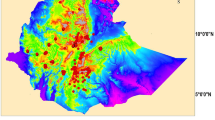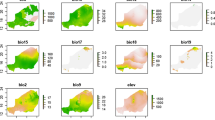Abstract
The present study is focused on the potential distribution of the Lebanese cedar (Cedrus libani) in the present and in the future throughout the twenty-first century. The location of this work encompasses Lebanon, Syria and Turkey. Twenty-four environmental variables are used and two Representative Concentration Pathways (RCP) scenarios for two different time periods are studied: RCP 4.5 2050, RCP 4.5 2070, RCP 8.5 2050 and RCP 8.5 2070. The most interesting novelty is the use of 13 General Circulation Models and 6 algorithms (Climate Space Model, Envelope Score, Environmental Distance, Genetic Algorithm for Rule-set Production, Maximum Entropy and Support Vector Machines) were considered for modelling. Area Under the Curve is used as goodness of fit and building the final consensus map. The global habitat suitability area would enlarge in the forecasted scenarios with respect to the present, although it would be more restricted in 2070 due to the altitudinal shift. This study also suggests an interesting approach to manage C. libani stands by means of afforestation programs aiming to face global warming in the late twenty-first century.



Similar content being viewed by others
References
Abi Saleh B, Safi S, Safi N, Hanna R, Nasser N, Tohme H (1996) Étude de la diversité biologique du Liban. Ministère de l’Agriculture (Liban). Flore terrestre (9). Projet GF/6105-92-72
Ahmad S, Yang L, Khan TU, Wanghe K, Li M, Luan X (2019) Using an ensemble modelling approach to predict the potential distribution of Himalayan gray goral (Naemorhedus goral bedfordi) in Pakistan. Glob Ecol Conserv. https://doi.org/10.1016/j.gecco.2019.e00845
Alptekin CU, Bariteau M, Fabre JP (1997) Le cèdre de Turquie: aire naturelle, insectes ravageurs, perspectives d’utilisation pour les reboisements en France. Rev Forestiere Fr 49:19–31
Atalay I (2002) Mountain ecosystems of Turkey. In: 7th international symposium on high mountain remote sensing cartography, ICA
Ayan S, Erkan Buğday S, Yer EN, Buğday E (2016) Stands characteristics of Cedrus libani A. Rich. natural forests in Turkey, Abstract Book, p 50, Résumés du colloque international Sous le thème: « Les espaces forestiers et péri-forestiers (EFPF): dynamique et défis » . Les 3-5 novembre 2016, Campus Universitaire Ait Melloul-Université IBN Zohr-Agadir, Morocco
Ayan S, Yer EN, Gülseven O (2017) Evaluation of Taurus cedar (Cedrus libani A. Rich.) afforestation areas in Turkey in terms of climate type. Artvin Çoruh University. J For Faculty 18:152–161
Ayasligil Y (1997) Cedrus libani A. Rich., 1823. Enzyklopa¨die der Holzgewa¨chse—10. Erg Lfg 12:1–10
Blondel J, Aronson J, Bodiou JY, Bœuf G (2010) The mediterranean region: biological diversity in space and time. Oxford University Press, Oxford
Booth TH, Nix HA, Busby JR, Hutchinson MF (2014) BIOCLIM: the first species distribution modelling package, its early applications and relevance to most current MaxEnt studies. Divers Distrib 20:1–9
Boydak M (2003) Regeneration of Lebanon cedar (Cedrus libani A. Rich.) on karstic lands in Turkey. For Ecol Manag 178:231–243
Camarretta N, Harrison PA, Bailey T, Potts B, Lucieer A, Davidson N, Hunt M (2020) Monitoring forest structure to guide adaptive management of forest restoration: a review of remote sensing approaches. New For 51:573–596
Chaney W, Basbous M (1978) The cedars of Lebanon: witnesses of history. Econ Bot 32:118–123
Cheddadi R, Henrot AJ, François L, Boyer F, Bush M, Carré M, Coissac E, De Oliveira PE, Ficetola F, Hambuckers A, Huang K, Lézine AM, Nourelbait M, Rhoujjati A, Taberlet P, Sarmiento F, Abel-Schaad D, Alba-Sánchez F, Zheng Z (2017) Microrefugia, Climate Change, and Conservation of Cedrus atlantica in the Rif Mountains. Morocco Front Ecol Evol 5:114
Conrad V (1946) Methods in climatology. Harvard University Press, Harvard, pp 296–300
Ducrey M, Huc R, Ladjal M, Guehl JM (2008) Variability in growth, carbon isotope composition, leaf gas exchange and hydraulic traits in the eastern Mediterranean cedars Cedrus libani and C. brevifolia. Tree Physiol 28:689
Ekici Aydin F, Ayan S, Özel HB, Yildirim G (2017) Marginal populations of Taurus cedar (Cedrus libani A. Rich). In: International symposium on New Horizons in forestry (ISFOR2017), Abstract Book, p 115, 18–20 October, Isparta, Turkey
Fady B, Lefevre F, Vendramin GG, Ambert A, Regnier C, Bariteau M (2008) Genetic consequences of past climate and human impact on eastern Mediterranean Cedrus libani forests, Implications for their conservation. Conserv Genet 9:85–95
Farjon A (2010) A handbook of the world’s conifers, vol 1. Brill, Leiden
Gardner M (2016) Cedrus libani. The IUCN red list of threatened species 2013: e.T46191675A46192926. http://dx.doi.org/10.2305/IUCN.UK.20131.RLTS.T46191675A46192926.en. Accessed 29 Oct 2016
Giordano G (1956) The Mediterranean Region. In: Haden-Guest S, Wright JK, Teclaff EM (eds) A world geography of forest resources. Ronald Press, New York, pp 352–371
Guisan A, Zimmermann NE (2000) Predictive habitat distribution models in ecology. Ecol Model 135:147–186
Hajar L, Francois L, Khater C, Jomaa I, Deque M, Cheddadi R (2010) Cedrus libani (A. Rich) distribution in Lebanon: past, present and future. CR Biol 333:622–630
Hernández PA, Graham CH, Master LL, Albert DL (2006) The effect of sample size and species characteristics on performance of different species distribution modeling methods. Ecography 29:773–785
Hijmans RJ, Cameron SE, Parra JL, Jones PG, Jarvis A (2005) Very high resolution interpolated climate surfaces for global land areas. Int J Climatol 25:1965–1978
Hutchinson GE (1957) Concluding remarks. Cold Spring Harbour Symp Quant Biol 22:415–427
IPCC (2014) Climate change 2014: synthesis report. Contribution of Working Groups I, II and III to the Fifth Assessment Report of the Intergovernmental Panel on Climate Change. IPCC, Geneva
Karataş R, Özkan K (2017) Relationships between the development of Taurus cedar (Cedrus libani A. Rich.) afforestation and the characteristics of the site conditions. J For Res 4:12–21
Khouzami M (1994) The Lebanese cedar forests. In: Proceedings of the first national conference on the Cedar of Lebanon, present and future. American University of Beirut, Lebanon
Khuri S, Shmoury MR, Baalbaki R, Maunder M, Talhouk SN (2000) Conservation of the Cedrus libani populations in Lebanon: history, current status and experimental application of somatic embryogenesis. Biodivers Conserv 9:1261–1273
Körner C (2007) The use of “altitude” in ecological research. Trends Ecol Evol 22:569–574
Linares JC, Taïquib L, Sangüesa-Barredac G, Secoa JI, Camarero JJ (2013) Age-related drought sensitivity of Atlas cedar (Cedrus atlantica) in the Moroccan Middle Atlas forests. Dendrochronologia 31:88–96
López-Tirado J, Vessella F, Schirone B, Hidalgo PJ (2018) Trends in evergreen oak suitability from assembled species distribution models: assessing climate change in south-western Europe. New For. https://doi.org/10.1007/s11056-018-9629-5
Messinger J, Guney A, Zimmerman R, Aas G (2015) Cedrus libani: a promising tree species for Central European forestry facing climate change? Eur J Forest Res. https://doi.org/10.1007/s10342-015-0905-z
MOA (Ministry of Agriculture) (2005) Forest and Tree resources Assessment for Lebanon. Final Report. FAO project under the Global Forest Resources Assessment
Musselman L (2007) Figs, dates, laurel, and myrrh: plants of the bible and the quran. Timber Press, China
Nemer N, El Beyrouthy M, Lahoud C, Mnif W, Bashour I, Kawar N (2014) The influence of soil properties on the development of Cephalcia tannourinensis Chevin (Hym. Pamphiliidae) infesting the cedar forests in Lebanon. Afr J Biotech 13:4369–4381
OGM (2015) Orman Genel Müdürlüğü Ağaçlandırma Daire Başkanlığı, ArcGIS programı veri bankası
Oner N, Uysal M (2009) Usability of the Taurus Cedar and Crimean Pine in green belt afforestations in semiarid regions in Turkey: a case study in Konya Province Loros Mountain—Akyokus. Afr J Agric Res 4:1049–1057
Pearson RG, Raxworthy CJ, Nakamura M, Townsend Peterson A (2007) Predicting species distributions from small numbers of occurrence records: a test case using cryptic geckos in Madagascar. J Biogeogr 34:102–117
Qiao CY, Ran JH, Li Y, Wang XQ (2007) Phylogeny and Biogeography of Cedrus (Pinaceae) Inferred from Sequences of Seven Paternal Chloroplast and Maternal Mitochondrial DNA Regions. Ann Bot 100:573–580
Quézel P, Médail F (2003) Ecologie et biogéographie des forêts du bassin méditerranéen. Elsevier, Paris
Regato P, Salman R (2008) Mediterranean mountains in a changing world: guidelines for developing actions plans, IUCN
Senitza E (1989) Waldbauliche Grundlagen der Libanonzeder (Cedrus libani A. Rich.) im Westtaurus/Turkei. Dissertation der Universitat fur Bodenkultur in Wien 34, Wien
Sevim M (1955) Lu¨bnan sedirinde yapılan bir kac go¨vde analizi ve sonucları (Zuwachsverha¨ltnisse der Libanonzeder). Rev Fac Sci For Univ Istanbul A3:48–53
Slimani S, Derridj A, Gutierrez E (2014) Ecological response of Cedrus atlantica to climate variability in the Massif of Guetiane (Algeria). For Syst 23:448–460
Swets JA (1988) Measuring the accuracy of diagnostic systems. Science 240:1285–1293
Talhouk SN, Zurayk R, Khuri S (2001) Conservation of coniferous forests of Lebanon: past, present and future prospects. Oryx 35:206–215
Touchan R, Xoplaki H, Funkhouser H, Luterbacher J, Hughes M, Erkan N, Akkemik U, Stephan J (2005) Reconstructions of spring/summer precipitation for the Eastern Mediterranean from tree-ring widths and its connection to large-scale atmospheric circulation. Clim Dyn 25:75–98
Ulbrich U, May W, Li L, Somot S (2006) The Mediterranean climate change under global warming. Dev Earth Environ Sci 4:399–415
Ürgenç S (1986) Afforestattion techniques. Istanbul Univ. Publication of Forestry Faculty, Nu: 3314/375, Istanbul
Vessella F, Simeone MC, Schirone B (2015) Quercus suber range dynamics by ecological niche modelling: from the last interglacial to present time. Quat Sci Rev 119:85–93
Vessella F, López-Tirado J, Simeone MC, Schirone B, Hidalgo PJ (2017) A tree species range in the face of climate change: cork oak as a study case for the Mediterranean biome. Eur J For Res 136:555–569
Funding
Financed by: FEDER, Junta de Andalucía-Consejería de Economía y Conocimiento. Proyecto UHU-1262837.
Author information
Authors and Affiliations
Corresponding author
Ethics declarations
Conflict of interest
The authors declare that they have no conflict of interest.
Consent to participate
Not applicable.
Consent for publication
Additional informed consent was obtained from all individual participants for whom identifying information is included in this article.
Additional information
Publisher's Note
Springer Nature remains neutral with regard to jurisdictional claims in published maps and institutional affiliations.
Electronic supplementary material
Below is the link to the electronic supplementary material.
Rights and permissions
About this article
Cite this article
López-Tirado, J., Vessella, F., Stephan, J. et al. Effect of climate change on potential distribution of Cedrus libani A. Rich in the twenty-first century: an Ecological Niche Modeling assessment. New Forests 52, 363–376 (2021). https://doi.org/10.1007/s11056-020-09798-y
Received:
Accepted:
Published:
Issue Date:
DOI: https://doi.org/10.1007/s11056-020-09798-y




